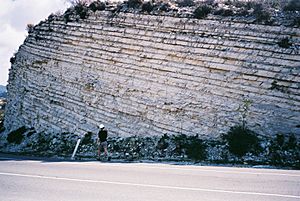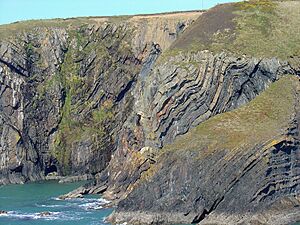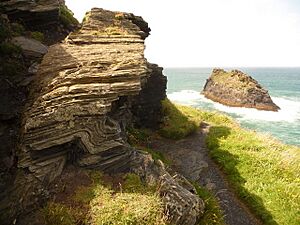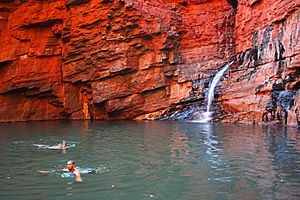Stratigraphy facts for kids
Stratigraphy is a part of geology that studies layers of rock. These layers are called strata. It's super important for understanding sedimentary rocks and layered volcanic rocks. By looking at these layers, scientists can learn about Earth's past.
Contents
How We Learned About Rock Layers
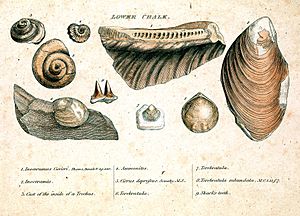
The study of stratigraphy began with a scientist named Nicolaus Steno. In his book De solido, he shared some key ideas:
- Law of Superposition: This rule says that in rock layers that haven't been moved, the oldest layers are always at the bottom. The layers on top were formed later.
- Principle of Original Horizontality: Steno also said that rock layers are usually laid down flat or horizontally. If you see them tilted or folded, it means something changed them after they formed.
- Principle of Lateral Continuity: This idea means that rock layers usually spread out sideways until something stops them. Imagine a blanket covering a floor; it spreads out until it hits a wall.
Later, in the late 1700s and early 1800s, a British scientist named William Smith started using stratigraphy in a practical way. People called him "Strata Smith" because he was so good at understanding rock layers. He made the very first geological map of England.
Smith discovered something amazing: he realized that fossils could help identify the same rock layers in different places. He collected many fossils from the layers he studied. His most important finding was:
- The Principle of Faunal Succession: This means that sedimentary rock layers contain different kinds of fossils. These fossils appear in a specific order, one after another, as you go up through the layers. This order is reliable and can be seen over large distances.
This idea was a big deal! It meant that if geologists found the same fossils in rock layers in different parts of the world, those layers were likely formed at the same time. It also suggested that the environment where the rocks formed might have been similar in those different places.
Types of Stratigraphy
There are different ways to study rock layers. Two main types are lithostratigraphy and biostratigraphy.
Lithostratigraphy: Studying Rock Types
Lithostratigraphy focuses on the physical type of rock itself. It looks at how the rock changes from one place to another. For example, a layer might be sandstone in one area and then change to shale in another. These changes in the rock, called facies changes, tell us about the different environments where the rocks were formed. The law of superposition is a basic idea here: the oldest rock layers are always at the bottom of an undisturbed sequence.
Biostratigraphy: Using Fossils to Date Rocks
Biostratigraphy uses the fossils found in rock layers to understand their age. If rock layers from different places have the same types of fossil fauna (animals) and flora (plants), it means they were formed around the same time.
This field is based on William Smith's principle of faunal succession. This principle was one of the first strong pieces of evidence for evolution. It shows how new species form (speciation) and how old ones disappear (extinction).
Scientists used biostratigraphy and the idea of faunal succession to create the geological timescale during the 1800s. This timescale first showed the relative ages of rocks (which layers were older or younger). Later, with the invention of radiometric dating, scientists could figure out the exact, absolute ages of these rock layers.
See also
 In Spanish: Estratigrafía para niños
In Spanish: Estratigrafía para niños


